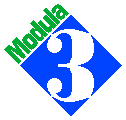 A Modula-3
Tutorial
A Modula-3
Tutorial
 A Modula-3
Tutorial
A Modula-3
Tutorial
This is a whirlwind tour of writing Modula-3 programs. By reviewing this tutorial, you will:
This tutorial assumes you already know how to use the CM3-IDE environment. To learn more about CM3-IDE, read the User Guide. For basic information about CM3-IDE, see Getting Started.
To learn more about Modula-3 and CM3, see:
 Getting Started:
If you are not familar with the CM3-IDE environment you may start
from Getting Started,
which contains all-around information about the CM3-IDE
environment.
Getting Started:
If you are not familar with the CM3-IDE environment you may start
from Getting Started,
which contains all-around information about the CM3-IDE
environment.
 User Guide:
If you have basic familiarity with CM3-IDE, but would
like to learn more about how to use it, read the User
Guide.
User Guide:
If you have basic familiarity with CM3-IDE, but would
like to learn more about how to use it, read the User
Guide.
 CM3-IDE Examples:
More than twenty ready-to-built, documented programs
demonstrate the use of everything from portable operating system
interfaces, to network objects, to web-server toolkit. If you have
learned the basics of the CM3-IDE environment and would like to get
some hands-on experience with it, review the CM3-IDE
Examples.
CM3-IDE Examples:
More than twenty ready-to-built, documented programs
demonstrate the use of everything from portable operating system
interfaces, to network objects, to web-server toolkit. If you have
learned the basics of the CM3-IDE environment and would like to get
some hands-on experience with it, review the CM3-IDE
Examples.
 Interface Index: If
you would like to read an overview of the standard Modula-3 libraries,
visit the Interface Index.
There is also a complete reference of
all available interfaces and
modules.
Interface Index: If
you would like to read an overview of the standard Modula-3 libraries,
visit the Interface Index.
There is also a complete reference of
all available interfaces and
modules.
 Trestle
By Example: Trestle is a portable windowing system. GUI
applications written using Trestle work transparently on top of Unix X
Window System (X11) and Microsoft Windows (Win32). If you would like
to learn more about Trestle and the available collection of Widgets,
read Trestle By Example.
Trestle
By Example: Trestle is a portable windowing system. GUI
applications written using Trestle work transparently on top of Unix X
Window System (X11) and Microsoft Windows (Win32). If you would like
to learn more about Trestle and the available collection of Widgets,
read Trestle By Example.
 Language Reference
To see a precise definition of the
Modula-3 Programming Language see the Language Reference.
Language Reference
To see a precise definition of the
Modula-3 Programming Language see the Language Reference.
 Books and Articles: More
than 50 books and articles are listed in a
comprehensive, annotated bibliography. There
is also a
concise version.
Books and Articles: More
than 50 books and articles are listed in a
comprehensive, annotated bibliography. There
is also a
concise version.